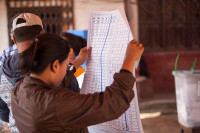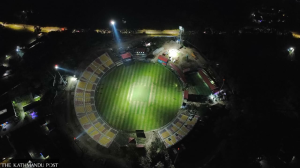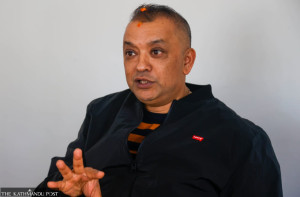Mon, Nov 17, 2025
Opinion
The show goes on
The combination of World Theatre Day (WTD) and hippies does not violate what the linguists would call ‘the semantic restriction rule’.
bookmark
Published at : April 1, 2018
Updated at : April 1, 2018 08:25
The combination of World Theatre Day (WTD) and hippies does not violate what the linguists would call ‘the semantic restriction rule’. Theatre and hippies are not uneasy bedfellows. Both are bonded by the mantra of theatre called performativity. In my long association with the International Theatre Institute (ITI) (presently, they have made me this Institute’s ‘honorary member’) it never occurred to me to bring the two into any one of my many discourses. As a theatre person and someone who was close to the hippies, albeit the fact that I did not follow their hard-core modus operandi, this year’s WTD made me not only pensive about this relationship, but also drove me to speak on the subject as proposed by Earthbeat Live, which is a conservation drama, dance and cultural research initiative of the Himalayan Culture Mill based in Kathmandu. This report published in The Kathmandu Post provides a clear explanation of the people and the mode of performance operation—”Performing artists Salil Subedi, Saroj Aryal, Sandeep Dangol and visual artist Manish Lal Shrestha started the performance act by moving a 5-metre long white canvas out into the open square from a small house corridor in sync with the drumming by the American musician Graham Shaw and Subedi’s didgeridoo vibrations” (March 29, 2018).
At this initiative, I had to conduct the discourse all on my own, and the topic I focused on was triggered by the fact that all of the above artists were initially trained at Sabine’s Studio 7 under her rigorous training. They followed the trail from the hippy sanctuary at Swoyambhu to Studio 7 in Bijeshwari, as reported in the Post. That the performing artists had followed that trail gave me the stuff for the discourse. The hippies, especially on full moon, pristine winter nights walked up and down the hill with ‘acid songs’, Bob Dylan’s hillbilly sound, Jimi Hendrix’s rock music and others’ equally powerfully loud music and singing. The so-called hippies were young people mainly from the West who thought they had discovered a most peaceful and great space called Kathmandu, and its sanctuaries like Swoyambhu, Pashupatinath and the old nooks and crannies of the lovely old towns of the Nepal Mandala. They arrived in hordes as it were, and magically fell into a pattern that was seen in their choice of the spaces, the trails they followed and the songs and music that attracted them. That these chaotic travellers fell into some pattern and created a cumulative culture is the crux of the movement. Anybody who wants to study them will miserably fail if he or she fails to see that dynamic and energy that rose out of what ostentatiously may appear chaotic and transformed itself into a system. Many misinterpretations arise from this very failure to recognise this.
Rejection of the Western mainstream
My experience and scholarship say that one element that impelled these so-called youths without any patterns of life to create a culture of their own was their recognition of the power of performance art, which I understand more clearly today than ever before because of my long experience in Nepal and abroad about performance culture and theatre. In retrospect, I would see that the major energy that guided them was rebellion and the creative anarchy that was seen in their dramatic, performative power. They chose their bodies as the theatre. Inspired by one hippie woman’s body theatre I wrote a poem entitled “A hippie woman” that is compiled in our collection of poems called Manas (1974) which is a joint collection of poems written by RAP (Ramesh Shrestha, Abhi Subedi, Peter Karthak). The hippies loved their bodies, respected the corporeality and put profound trust in what the body could perform or express. They were indeed releasing their energy, freeing their bodies constrained under the bourgeois and capitalist values of the societies that they were shunning to seek meaning out in the world. That was not a mean achievement at a time when the Western hegemony and the racist attitudes governed the thinking of those whom Graham Hancock calls in his book “Lords of Poverty” (1997). Hancock concluded, “the aid business does indeed have much to hide”. That process continues under new garbs of orientalism. The lords of a different order exercise their power by playing with the poverty of countries like Nepal and others that is also a result of the corruption of the rulers and political stakeholders. The hippies came out of the Western societies, rejecting that uncanny business of thriving on others’ poverty.
The hippies were not political activists. Like theatre artists they chose a great medium of performance. I told the theatre people gathered at Studio 7 that the hippies chose two methods of performance—walking and performing through body that included the sound. I said, ‘you exactly did the same today. You followed the same trail and ended it here at the studio of Sabine Lehman who was also an erstwhile hippie, a creative anarchist who set up this Vajra and the theatre. You are walkers; you are performers. Your design of the two characters shrouded in cocoon and emerging out by tearing that veneer when artists splashed them with colour, is exactly what the rebellious and performative youths of that period did in reality.”
A culture of performance
On World Theatre Day we read out a message written by one prominent theatre person of the world. This time the ITI had sent out three different messages. The ITI information circular says, “World Theatre Day was created by the ITI, the world’s largest organisation for the Performing Arts, and was celebrated for the first time on 27 March 1962”. We chose one written by theatre person Ram Gopal Bajaj of India. I had translated that into Nepali and read out. By asking me to link the hippie experience to the World Theatre Day, the young generation of theatre artists were showing a unique shift in their taste, that of finding out the source of energy that is needed to save our minds. I am glad they chose this theme. I will share this piece with the ITI World and call upon all to revive the great memories of saving theatre through performances.
Editor's Picks
Floodlights. Camera. Action. Stage set for second NPL season
26 years after IC814 hijack, Nepal’s airport security still weak: Report
Ghising’s ties to new party spark debate
22 percent of Kathmanduites over 30 are diabetic
We might have to request people to contest elections on Nepali Congress ticket
E-PAPER | November 17, 2025
×




 14.12°C Kathmandu
14.12°C Kathmandu









